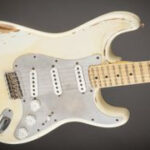Eastman guitars have carved a niche for themselves by offering instruments that often punch above their weight class, blending quality construction with appealing price points. Among their offerings, the parlor guitar models, particularly the E20P, have garnered attention for their compact size and promising sound. Recently, I had the opportunity to road-test an Eastman E20P, anticipating a rosewood model based on a dealer’s expectation, though a mahogany version was also in consideration. This hands-on experience revealed a guitar with impressive tonal qualities, yet some notable drawbacks, particularly concerning string spacing.
Upon inspection, the nut spacing appeared similar to a standard Martin 1 3/4″ nut, although Eastman officially lists the nut width at 1 13/16″. However, the real surprise came with the saddle spacing. Measuring under 1 1/16″, it presented a significantly tighter string arrangement than expected, even narrower than some Martin dreadnoughts which typically feature 2 1/8″ spacing. This close spacing proved to be a considerable hurdle for fingerstyle playing, feeling cramped and uncomfortable despite potentially suiting flatpickers.
Aside from the string spacing issue, the guitar’s playability was generally acceptable. While the nut spacing could be addressed with adjustments, the bridge spacing would require more extensive modification. Tonally, the E20P impressed. It exhibited excellent projection and volume, delivering a sound that, while not mimicking the classic Martin voice, was rich and resonant in its own right.
The top wood seemed to be Adirondack spruce, although the reviewer noted a possibility of it being Tibetan spruce. The grain pattern was tight near the center seam (around 10 lines per inch) and widened towards the lower bout edges (3-4 lines per inch), indicating a nicely grained top. The back and sides featured modestly wide-grained East Indian rosewood, adding to the guitar’s visual appeal.
The fingerboard was stained ebony. The staining exhibited some minor inconsistencies, with slight haphazardness on the bass side edge and some spotty areas near the soundhole end. However, these were considered minor cosmetic details. A positive aspect was the reduced gloss finish on the neck, enhancing playability.
Alt text: Close-up of the ebony fingerboard on an Eastman E20P parlor guitar, showing the grain and finish.
Unfortunately, the review unit presented some noticeable cosmetic flaws. These included scuffing and scratches on the treble side of the top, extending from the neck towards the edge of the upper bout. More concerning were approximately 15-20 fingernail dings in the area where a pickguard would typically be placed. These dings penetrated the wood finish and were not buffable, detracting from the guitar’s overall condition.
Considering its inherent qualities, the price point of the Eastman E20P would be reasonable if these flaws were absent. However, with the existing imperfections, a price reduction of a couple of hundred dollars would be warranted. Ultimately, the reviewer decided against pursuing a purchase at the offered price.
Despite these niggling issues, and provided a player can adapt to or address the tight string spacing, the Eastman E20P presents itself as a fine instrument. It’s almost enjoyable to play, boasting a surprisingly big voice for a small-bodied guitar. However, it’s important to acknowledge that it doesn’t quite reach the level of esteemed brands like Martin, Collings, or Santa Cruz in overall refinement and build quality.
For players seeking a high-end parlor guitar, models like the Martin 0-28VS (or potentially 0-28SV) are considered excellent and worth the investment, especially when purchased at a discounted price. The dealer mentioned they would notify the reviewer when a mahogany Eastman parlor guitar becomes available, suggesting continued interest in exploring the Eastman parlor guitar range despite the shortcomings of this particular rosewood E20P model.
In conclusion, the Eastman E20P offers a compelling combination of tone and compact size, making it an attractive option for players seeking a parlor guitar. However, the notably tight string spacing and potential for cosmetic imperfections are factors to carefully consider. While it may not compete directly with top-tier brands, it holds its own as a value-driven instrument with a distinctive voice.

